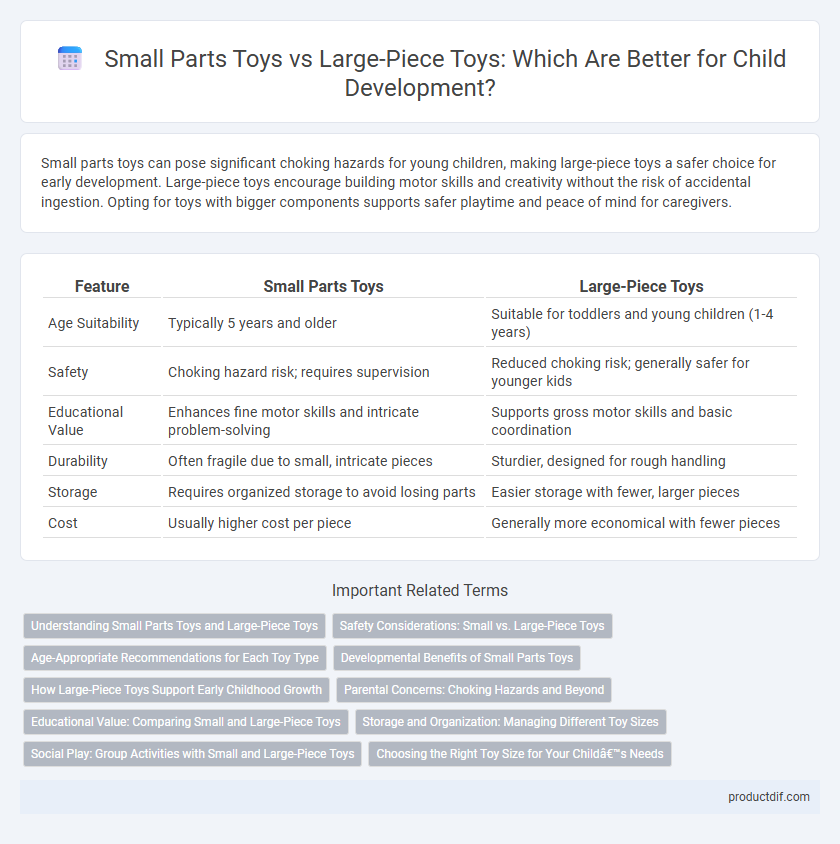Small parts toys can pose significant choking hazards for young children, making large-piece toys a safer choice for early development. Large-piece toys encourage building motor skills and creativity without the risk of accidental ingestion. Opting for toys with bigger components supports safer playtime and peace of mind for caregivers.
Table of Comparison
| Feature | Small Parts Toys | Large-Piece Toys |
|---|---|---|
| Age Suitability | Typically 5 years and older | Suitable for toddlers and young children (1-4 years) |
| Safety | Choking hazard risk; requires supervision | Reduced choking risk; generally safer for younger kids |
| Educational Value | Enhances fine motor skills and intricate problem-solving | Supports gross motor skills and basic coordination |
| Durability | Often fragile due to small, intricate pieces | Sturdier, designed for rough handling |
| Storage | Requires organized storage to avoid losing parts | Easier storage with fewer, larger pieces |
| Cost | Usually higher cost per piece | Generally more economical with fewer pieces |
Understanding Small Parts Toys and Large-Piece Toys
Small parts toys often contain components smaller than 1.75 inches, which pose choking hazards for children under three years old, making them suitable for older kids with improved fine motor skills. Large-piece toys, such as oversized building blocks or chunky puzzles, are designed to promote safe play for toddlers and young children by minimizing swallowing risks and encouraging gross motor development. Understanding the size, safety guidelines, and developmental benefits helps caregivers choose appropriate toys that foster both cognitive and physical growth.
Safety Considerations: Small vs. Large-Piece Toys
Small parts toys pose choking hazards for children under three years, making age-appropriate labeling and supervision essential. Large-piece toys reduce the risk of ingestion and airway obstruction, offering safer options for younger children or those prone to mouthing objects. Parents should prioritize toys that meet safety standards such as ASTM F963 and consider the child's age and developmental stage to minimize accident risks.
Age-Appropriate Recommendations for Each Toy Type
Small parts toys are ideal for children aged three years and older due to choking hazards, while large-piece toys suit toddlers and preschoolers by promoting motor skills without safety risks. Age-appropriate recommendations stress selecting toys that align with developmental milestones, such as fine motor control for small pieces and gross motor skills for larger blocks. Choosing the right toy size enhances safety and supports cognitive and physical growth effectively.
Developmental Benefits of Small Parts Toys
Small parts toys enhance fine motor skills by encouraging precise hand-eye coordination and dexterity in children. These toys also promote cognitive development through problem-solving activities, improving focus and spatial awareness. Engaging with small parts toys fosters creativity and patience, essential for early childhood growth and learning.
How Large-Piece Toys Support Early Childhood Growth
Large-piece toys play a crucial role in early childhood development by enhancing fine motor skills and hand-eye coordination through easier grasping and manipulation. These toys also stimulate cognitive growth by encouraging problem-solving and imaginative play without the frustration often caused by small, intricate parts. Safety is increased with large-piece toys as they reduce choking hazards, providing a secure environment for toddlers to explore and learn.
Parental Concerns: Choking Hazards and Beyond
Small parts toys present significant choking hazards, making them a top concern for parents of young children under three years old. Large-piece toys reduce the risk of ingestion and are favored for promoting safe play while supporting motor skill development. Beyond choking, parents also worry about toxicity, durability, and age-appropriateness when selecting toys for their kids.
Educational Value: Comparing Small and Large-Piece Toys
Small parts toys enhance fine motor skills and cognitive development by encouraging precision and problem-solving through intricate manipulation. Large-piece toys support spatial awareness and gross motor skills, making them ideal for younger children developing hand-eye coordination. Both types contribute uniquely to educational growth, with small parts fostering detailed focus and large pieces promoting overall physical and cognitive engagement.
Storage and Organization: Managing Different Toy Sizes
Small parts toys require specialized storage solutions such as compartmentalized bins or stackable containers to prevent loss and ensure easy access during playtime. Large-piece toys benefit from spacious, open storage units like shelving or oversized bins that accommodate their bulk without causing damage. Effective organization strategies include labeling containers and grouping toys by size to maintain a clutter-free environment and streamline cleanup processes.
Social Play: Group Activities with Small and Large-Piece Toys
Small parts toys encourage fine motor skills and cooperation among children during group activities, fostering creativity and detailed interaction. Large-piece toys enhance social play by facilitating teamwork and communication as kids collaboratively build and share their creations. Both types of toys support social development, with small parts improving precision and focus, while large pieces promote collective problem-solving and group engagement.
Choosing the Right Toy Size for Your Child’s Needs
Small parts toys pose choking hazards for children under three years old, making large-piece toys a safer choice for toddlers developing fine motor skills. Selecting toy sizes that match your child's age and developmental stage enhances both safety and learning outcomes. Large-piece toys encourage creativity and problem-solving while minimizing the risk of ingestion or injury.
Small parts toys vs large-piece toys Infographic

 productdif.com
productdif.com